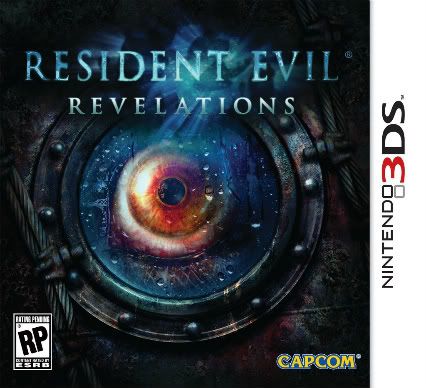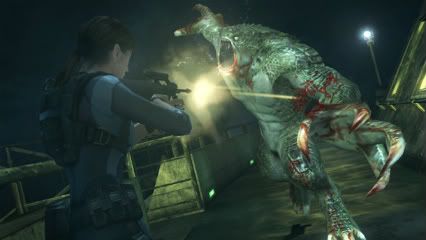
- Format: 3DS
- Unleashed: Out Now
- Publisher: Capcom
- Developer: Capcom
- Players: 1-2
- Site: http://www.residentevil.com/revelations/
Resident Evil: Revelations can probably be considered one of the more mature games to be released on the 3DS to date (though it only manages a 16 rating from PEGI) and from the outset was a refreshing change from Mario, Mario, some remake, and that other Mario game.
Jumping into the newest Resident Evil title is a little daunting at first because it feels like being forced to start at episode ten of a twenty episode season. Despite having no direct ties to the plot of previous titles with the exception of Chris, Jill and the BSAA group they work for, the player is fed a lot of information about significant previously unknown events of a global scale.
We’re told that in 2004 a city was created out at sea which ran on 100% solar power. This city, called Terragrigia, was for some reason the prime target of a terrorist group named Veltro which chose to attack it using bio organic weapons to zombify the population of the city with a new virus variant called T-Abyss. Pulling another Raccoon City, the government decided that the only way to contain the virus was to blow up the city. Skip ahead one year and Chris has gone missing chasing rumours that Veltro has resurfaced; so Jill and new partner Parker go searching for him on orders of the BSAA boss – who looks so much like the late Peter Falk that it’s distracting.

The story is ridiculous even if you do manage to swallow everything that’s happened before the events which play out in the game, but that is not to say it’s bad. Most people probably go into a Resident Evil game expecting nothing more than a cheesy action horror plot with monsters and zombies thrown in, so as long as that doesn’t change here you’ll be fine. That said you do also have to cope with it jumping around timeline wise a lot; sometimes by a year, sometimes by an hour, sometimes by mere minutes to tell events from another perspective.
Controls are tight and responsive and players of Resident Evil 4 or 5 will feel instantly at home, though using the new dodge ability takes some getting used to. The circle pad attachment is utterly unnecessary for playing the game to the required standard of reaction times and aiming prowess.
Presentation is to a very high standard. We don’t just mean graphically either (though it’s one of the best looking 3DS games we’ve played to date), more that Capcom has tried very hard to make the 3D worth having on. Now, 3D always has and always will be an unnecessary gimmick and a lot of developers are using it just as that – something to tack on to justify being on this handheld. Revelations feels like it’s better with the 3D on, even if it technically isn’t. Each cutscene, each camera angle, each panning shot feels like it was choreographed so that with the 3D slider up full it looks better. It isn’t too ‘deep’ either, so much like The Mercenaries 3D eye strain from prolonged play isn’t really an issue either, yet you still get enough visual depth that it adds an important effect.

Either by design or format limitations, Revelations returns to a more enclosed experience. You spend a vast majority of it on the ship traversing tight corridors never sure what’s around the next corner. The 3D effect helps amplify this feeling of heightened caution as you awkwardly edge around the corner (or cheat using the finger dexterity requiring first person strafe returning from The Mercenaries 3D). That’s not to say there aren’t large rooms or other areas because there are, and they help break up the experience. The first time you see the hall of the promenade deck you’ll be impressed by both the visuals and the scale.
As with previous games the gameplay boils down to finding weapons, upgrading weapons, shooting enemies and solving relatively simple puzzles. There is both forced and optional backtracking across twelve episodes which will take you around nine hours to get through, which is a very healthy length.
If we were to nitpick at things it would be that the game goes on for about another hour after it feels like it’s reached a satisfying conclusion, bosses take about five minutes longer to kill than they should, the ‘previously on Resident Evil: Revelations’ sections at the beginning of each episode are truly painful, and if you watch the after credits cutscene all it does is confound you and bring up all sorts of nasty plot holes.

So, what else is there besides a nine hour or so campaign mode that you’ll play through once or twice? Thankfully the game has that covered in the form of Raid Mode. This is where the game’s excellent local or internet co-op comes into action (though it can also be played alone if need be).
Raid Mode lets you pick a character from the main story and then you play through enclosed levels with different enemy and item layouts, levelling up as you go and finding better gear too. You can run into special versions of enemies which are super quick, super tough, or a mixture of the two and players can even fight bosses together. There are also achievement-like missions which can be traded with people you co-op with or via StreetPass.
It’s a great shame the co-op couldn’t also apply to the main campaign, but Raid Mode is a clever addition to an already full feeling game which will create longevity it wouldn’t have otherwise had. For those still in two minds about trying Revelations a demo is available on the eStore; but few people would be disappointed after playing this game.


















Comments